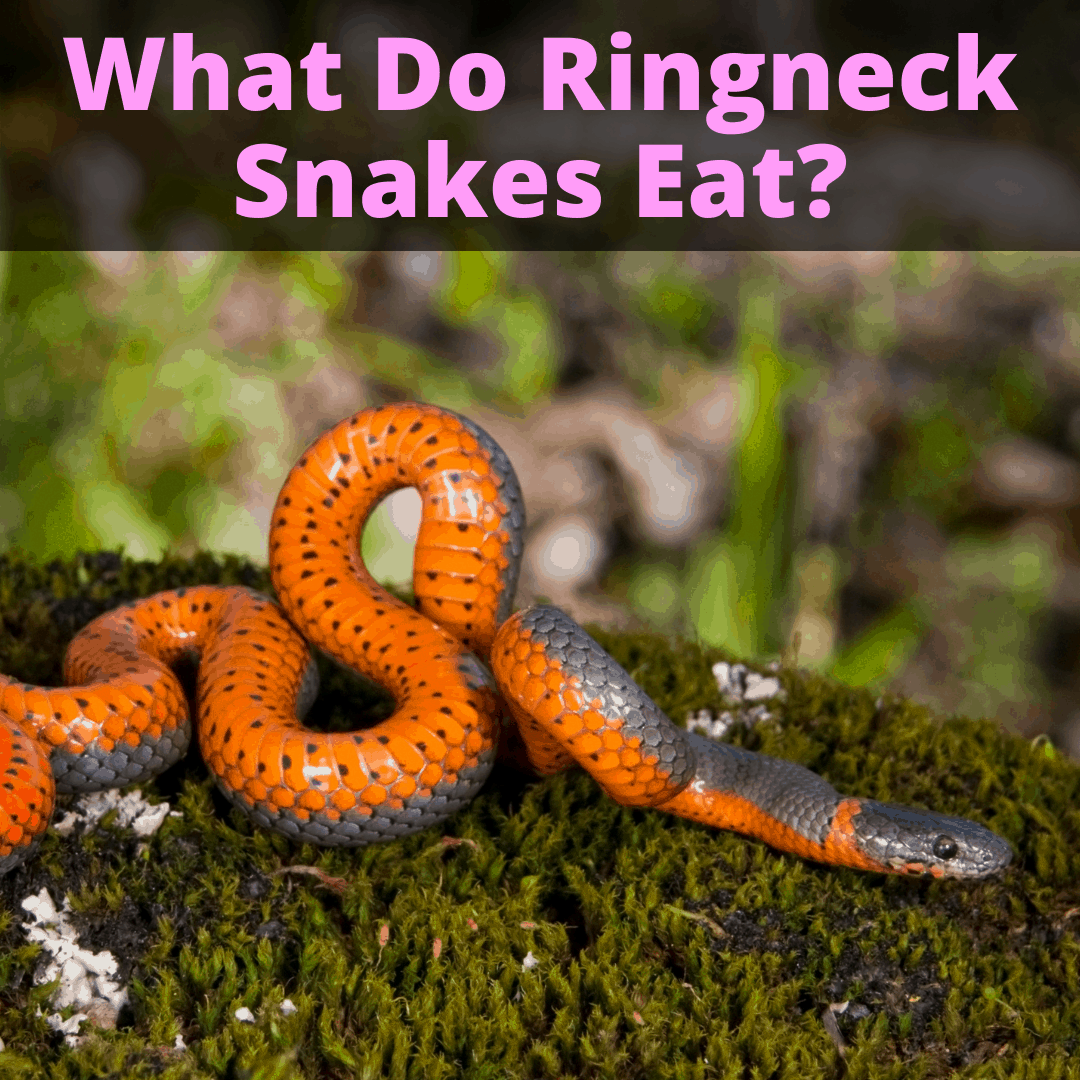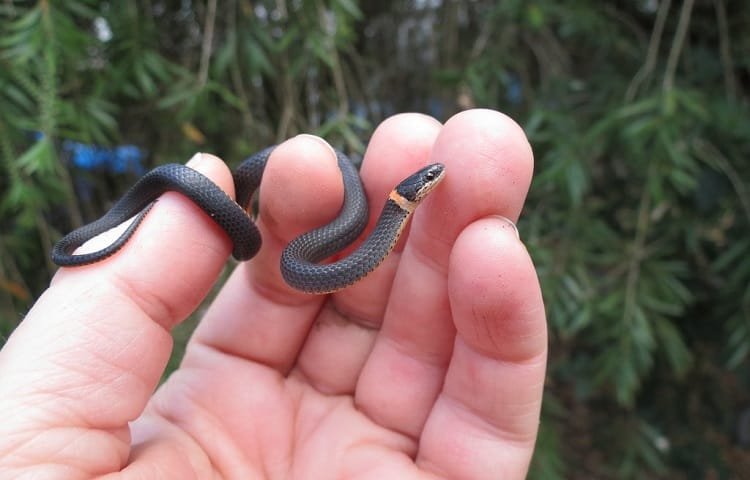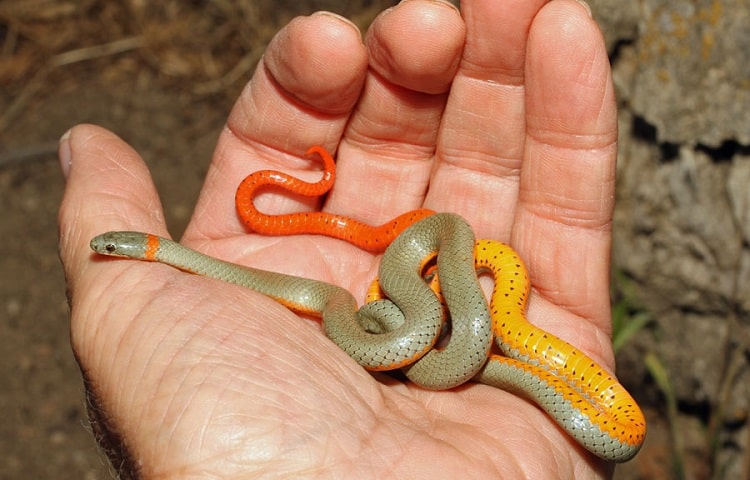
The others are their small size and docile nature.
It all makes one of the easiest snakes to care for.
They don’t take up much space, they pose no danger, and they are beautiful, with their dark color and the orange or yellow collar that lends them their name.
They also don’t need to eat rats or mice.
A lot of owners feel squeamish about feeding their pets dead rodents, and even more so if the rodents are alive.
So what does the ring necked snake eat then?
Keep reading to learn everything you need to know about the ringneck snake’s dietary habits.
What Do Ring Necked Snakes Eat?
Generally, ringneck snakes feed on slugs, insects, insect larvae, small reptiles, small amphibians, and earthworms.
If you don’t like the idea of feeding your pet snake rodents or larger prey, you’ll love the ringneck snake, because you can feed it insects.
With that in mind, let’s find out how to ensure you give your pet ringneck snake a healthy, rich diet. We’ll also look at how to set up the ideal habitat.
What To Feed A Ring Necked Snake

Even though ringneck snakes can eat prey like frogs, salamanders, and mice, you don’t need to worry about providing this food for your pet.
It will be quite quite happily eat a diet filled with crickets and earthworms. If the ringneck is larger in size, it might be able to eat larger prey like voles or mice. But even for larger ringnecks, they will be perfectly happy with earthworms and insects.
How Often To Feed A Ringneck Snake
While feeding schedules vary from one type of snake to another, with some snake species being able to go for two weeks without food, that’s not the case with ringnecks.
You should feed them two to four times per week. You also need to keep a dish of water in their enclosure so they always have fresh, clean water available.
How To Keep A Ringneck Snake As A Pet

If you want to keep a ringneck snake as a pet, you need to ensure that you give it the proper diet, as outlined above. It also needs a habitat that mimics its natural environment. And you should give it a great snake name.
Here are some important tips to follow when setting up an enclosure for your ringneck.
- You should provide UV light for your ringneck snake, either by using a UV bulb or from natural daylight. These snakes prefer cooler temperatures so you don’t want to overdo it with too many heat lamps.
- Ringneck snakes are solitary creatures, just like other snakes. Avoid keeping adult snakes together in the same enclosure. This isn’t just because two snakes in the same tank result in a fiery competition for food and other resources. Ring necked snakes have mild cannibalistic tendencies and one may eat the other! In addition, these snakes are timid and shy, and they avoid contact with each other even in the wild.
- They like damp habitats. In the wild, they can be found in swamps, holes in the ground, or along banks of rivers. A pool of water inside their enclosure is a good idea.
- Ringneck snakes are tropical or semi-aquatic snakes. They thrive when humidity levels are between 50 and 80 percent, so make sure you ensure this for their enclosure. A humidity gauge is vital to maintain the correct humidity levels.
- Make sure you give your ringneck snake a light misting every day, because they like to have moisture in their enclosures. This helps increase humidity as well.
- Give your ring necked snake the chance to climb. Although they’re not known for being excellent climbers, they do like the opportunity to climb. Put some vines or branches in their enclosure. This will keep them entertained.
- The ideal temperature of your ringneck snake enclosure is between 70 and 75 degrees Fahrenheit. A low-watt basking light or heat emitter can help you to maintain a good temperature for the snake.
- Avoid under-tank heating. This is not necessary for your ring necked snake and it can cause problems like dehydration.
- These snakes like to dig! In the wild, they can be found nesting or hiding underneath piles of leaves or in holes in the ground, so give them the chance to mimic this behavior. Providing them with loose substrate or leaves. An even better idea is to give your ringneck snake three inches of sand or peat moss to dig around in.
Good Enclosure For Your Ring Necked Snake

These snakes are small and thin creatures that don’t become too big even when they reach adulthood. They generally only grow to 10 to 15 inches in size.
This means they don’t need a large terrarium. An enclosure that is a bit larger than a shoebox is enough space for them, though more space is always better.
Related Questions
Are ring necked snakes venomous?
Ringneck snakes are mildly poisonous. They have small amounts of venom in their saliva, but this is not potent enough to harm us. They’re also not aggressive, so they won’t bite unless they need to attack prey.
How long do ringneck snakes live?
The average lifespan of a ring necked snake is between six and 10 years.
Ring Necked Snake Diet: Conclusion
The ringneck snake makes a great pet due to its small size and docile nature. Many owners love that they don’t have to feed it rodents, since it is perfectly happy to eat nothing but insects or earthworms. This all combines to make it one of the easiest snakes to care for.

Leave a Reply